Hornbeam, planting guide and care work
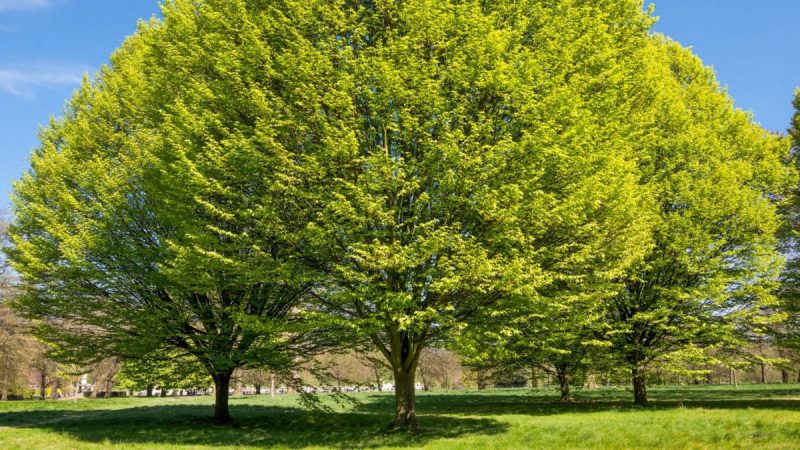
Hornbeam (Carpinus) is a genus of deciduous trees in the Betulaceae family, native to North America, Europe, and Asia. They are widespread in temperate areas of the northern hemisphere. Most species are found in China. They are medium to large trees, with a height of up to 30 m.
The trunk is irregular, with superficial longitudinal hollows (similar to the ones of beech trees). The leaves are 3-10 cm long, are alternately arranged on the branches, are simple, and have a serrated edge. They are monoecious species, with male and female inflorescences on the same plant. They are in the form of pendant catkins. Pollination is done by the wind. The fruit consists of a nut, provided with a membranous bract, often trilobate. Hornbeam is a tree with low longevity. It produces a lot of shoots, but not root suckers. It is usually planted in parks and gardens, alone or in groups. It is often used for fences and green walls. Hornbeam wood is a hardwood, from which musical instruments, tools, parquet, or chess pieces are made.
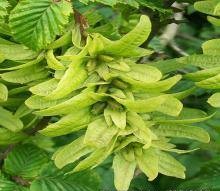
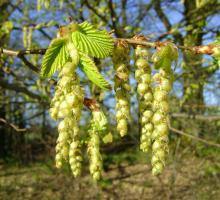
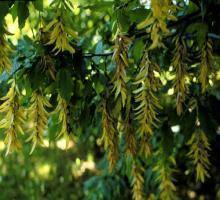
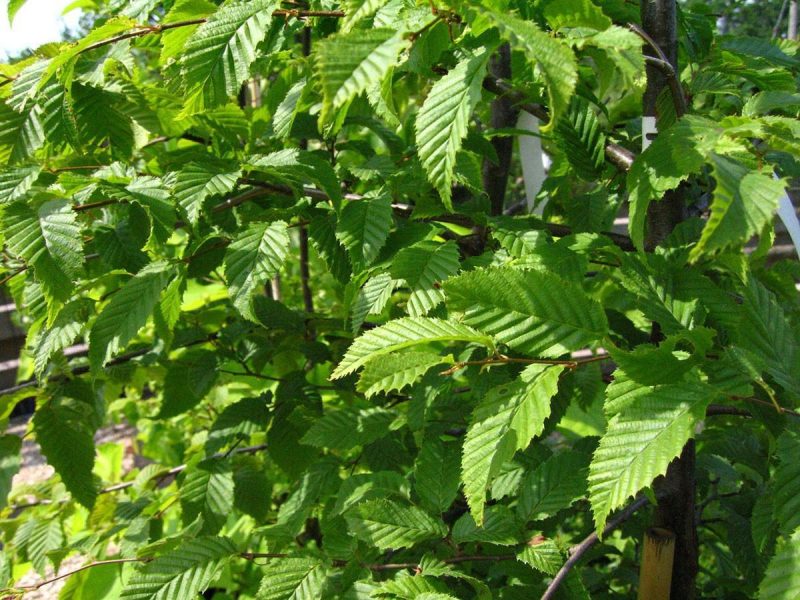
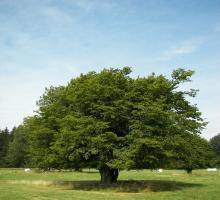
Species and varieties
Carpinus betulus (European hornbeam)
It is a native species. It grows as a size II tree, forming a wide and thick crown. The leaves are arranged in two opposite rows, on either side of the branches, and are double-serrated. In autumn, it acquires a rusty color. The inflorescences appear in spring, at the same time as the leaves. Varieties:
- ‘Fastigiata’ – narrow, pyramidal crown. The branches grow upwards.
- ‘Pendula’ – a dwarf variety. It has thin branches, pendant.
Carpinus orientalis (carpinita)
it is an indigenous species. It can grow as a small tree or shrub. It has slow growth and forms a thick crown. It has dark green, glossy foliage. The leaves are smaller than in other species.
Carpinus caroliniana (American hornbeam)
It is native to North America. It grows as a short tree or shrub, forming a globular crown. The leaves are dark green, and in autumn it acquires shades of yellow, copper, red.
Environmental conditions
Light. Hornbeams are light-loving trees, but they also grow in partially shaded places.
Temperature. C. betulus and C. caroliniana are frost-resistant species. C. orientalis is a thermophilic species, sensitive to low temperatures. In general, hornbeams do not tolerate drought.
Soil. Hornbeam has no special requirements for the soil, it grows best on fertile, rich, and permeable soils.
Fertilization
To stimulate the rich growth of trees and shrubs, during the vegetative growth period, it is recommended to apply specific fertilizers.
Recommended products
-
You can find products on a different store
Change Store -
You can find products on a different store
Change Store -
You can find products on a different store
Change Store -
You can find products on a different store
Change Store -
You can find products on a different store
Change Store -
You can find products on a different store
Change Store -
You can find products on a different store
Change Store -
You can find products on a different store
Change Store -
You can find products on a different store
Change Store -
You can find products on a different store
Change Store -
You can find products on a different store
Change Store -
You can find products on a different store
Change Store -
You can find products on a different store
Change Store -
You can find products on a different store
Change Store -
You can find products on a different store
Change Store -
You can find products on a different store
Change Store -
You can find products on a different store
Change Store -
You can find products on a different store
Change Store -
You can find products on a different store
Change Store -
You can find products on a different store
Change Store -
You can find products on a different store
Change Store -
You can find products on a different store
Change Store -
You can find products on a different store
Change Store -
You can find products on a different store
Change Store
Pruning
Some trees can easily withstand pruning. During the dormancy period, shape correction cuts can be made.
Recommended products
-
You can find products on a different store
Change Store -
You can find products on a different store
Change Store -
You can find products on a different store
Change Store -
You can find products on a different store
Change Store -
You can find products on a different store
Change Store -
You can find products on a different store
Change Store -
You can find products on a different store
Change Store -
You can find products on a different store
Change Store -
You can find products on a different store
Change Store -
You can find products on a different store
Change Store -
You can find products on a different store
Change Store -
You can find products on a different store
Change Store -
You can find products on a different store
Change Store -
You can find products on a different store
Change Store -
You can find products on a different store
Change Store -
You can find products on a different store
Change Store -
You can find products on a different store
Change Store -
You can find products on a different store
Change Store -
You can find products on a different store
Change Store -
You can find products on a different store
Change Store -
You can find products on a different store
Change Store -
You can find products on a different store
Change Store -
You can find products on a different store
Change Store -
You can find products on a different store
Change Store
Planting
Planting should be done in spring or autumn, during the vegetative dormancy period, at temperatures above 5° C, if the soil is not frozen and there is no danger of frost. Be sure to purchase planting material from authorized nurseries. Immediately after planting, water abundantly, then keep the soil always moist.
Propagation
Hornbeam can be propagated through seeds, cuttings, or grafting.
- the seeds are harvested in the first-fruits phase, layered for a year, after which they have to be planted in February-March (next spring).
- propagation through cuttings is done with portions of semi-lignified shoots.
- grafting is done in the greenhouse, by copulation or triangulation. It is a procedure recommended for professionals.
Recommended products
-
You can find products on a different store
Change Store -
You can find products on a different store
Change Store -
You can find products on a different store
Change Store -
You can find products on a different store
Change Store -
You can find products on a different store
Change Store -
You can find products on a different store
Change Store -
You can find products on a different store
Change Store -
You can find products on a different store
Change Store -
You can find products on a different store
Change Store -
You can find products on a different store
Change Store -
You can find products on a different store
Change Store -
You can find products on a different store
Change Store -
You can find products on a different store
Change Store -
You can find products on a different store
Change Store -
You can find products on a different store
Change Store -
You can find products on a different store
Change Store -
You can find products on a different store
Change Store -
You can find products on a different store
Change Store -
You can find products on a different store
Change Store -
You can find products on a different store
Change Store -
You can find products on a different store
Change Store -
You can find products on a different store
Change Store -
You can find products on a different store
Change Store -
You can find products on a different store
Change Store
Diseases and pests
Diseases that can affect hornbeam trees are powdery mildew and Nectria canker. Among the pests that can infest hornbeam trees are aphids and various species of caterpillars.
Recommended products
-
You can find products on a different store
Change Store -
You can find products on a different store
Change Store -
You can find products on a different store
Change Store -
You can find products on a different store
Change Store -
You can find products on a different store
Change Store -
You can find products on a different store
Change Store -
You can find products on a different store
Change Store -
You can find products on a different store
Change Store -
You can find products on a different store
Change Store -
You can find products on a different store
Change Store -
You can find products on a different store
Change Store -
You can find products on a different store
Change Store -
You can find products on a different store
Change Store -
You can find products on a different store
Change Store -
You can find products on a different store
Change Store -
You can find products on a different store
Change Store -
You can find products on a different store
Change Store -
You can find products on a different store
Change Store -
You can find products on a different store
Change Store -
You can find products on a different store
Change Store -
You can find products on a different store
Change Store -
You can find products on a different store
Change Store -
You can find products on a different store
Change Store -
You can find products on a different store
Change Store
In addition:
- in the first years, hornbeams have a slow growth, after which they grow quite fast.
- C. betulus is resistant to air pollution and is suitable for urban environments.
- the fruits develop after 15-20 years.















































































































































































































































































































































































































































